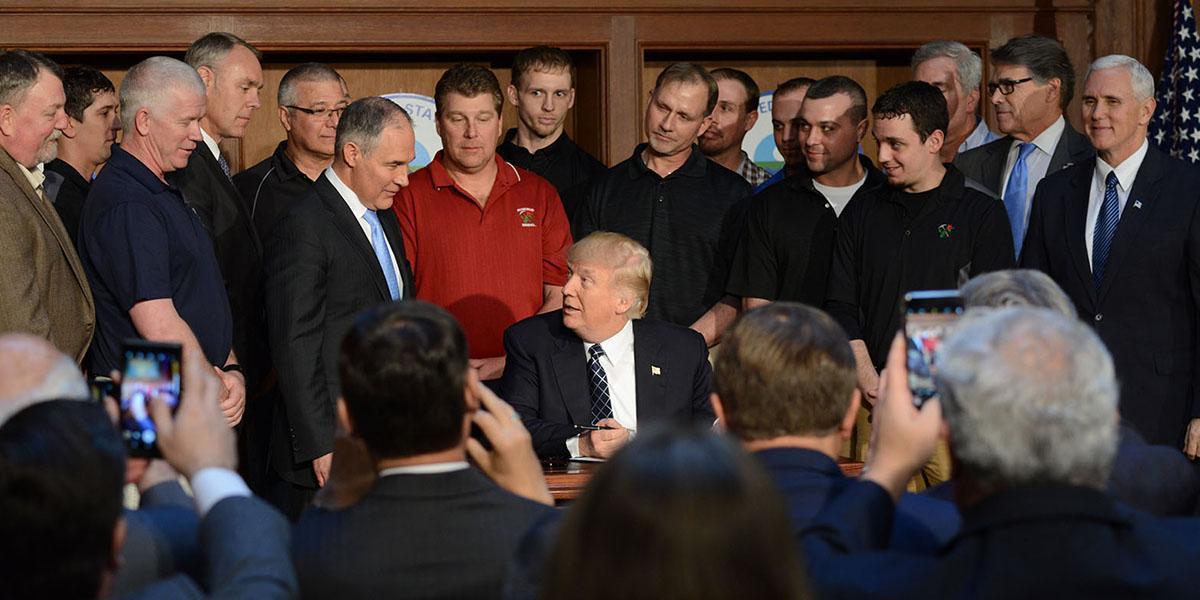

By Eric Pooley
President Trump said recently that the tradition of rating a new president’s first 100 days is “ridiculous.” The White House then created a web page devoted to rating his first 100 days.
It’s further proof, if anyone needed it, that the defining feature of this president’s first 100 days is noise. Every day brings some piercing new alarm, making it hard to separate the momentarily disturbing from the truly damaging. But this is essential—especially for the environment.
While the president has flip-flopped on some signature issues, he’s been totally consistent about dismantling protections for public health, clean air and clean water. So let’s take a closer look at what he’s done so far, and what it will mean for our health and our world.
Here are the four worst actions Trump took during his first 100 days—and one that’s very good:
1. Hired Scott Pruitt
Trump’s choice of leader for the U.S. Environmental Protection Agency (EPA) built his career by attacking the agency and its clean air and water rules.
Pruitt is beginning to staff the EPA with Beltway insiders who have made their living lobbying for weaker pollution rules on behalf of industry.
For example, it has been widely reported that Andrew Wheeler may be named as Pruitt’s top deputy. Wheeler is now a lobbyist for Murray Energy, a coal mining conglomerate that is demanding an end to the rule that limits mercury pollution.
In fact, a recent analysis by Columbia University Law School showed that more than one quarter of the administration’s appointees so far to environmental, energy and natural resource agencies have close ties to the fossil fuel industry. The likely result: Thousands of decisions over the next four years made by those more interested in protecting polluters than public health.
That will leave a toxic legacy of more disease and premature death.
2. Undermined Chemical Safety
Last year, a bipartisan Congress overwhelmingly passed the Lautenberg Act, a new chemical safety law that, after four decades of a broken system that flooded our stores and homes with dangerous or untested chemicals, finally constructed a strong chemical safety net.
But now the EPA has to finish writing the rules to implement it. For that, Pruitt has chosen Nancy Beck, an insider straight from the main chemical industry trade association who even within the last few weeks lobbied the agency on these very rules.
If those new rules give industry everything it wants, we’ll have blown a historic chance to restore public trust and market confidence in the products consumers buy for household use. Our health would continue to be at risk—and undoing the damage would take years.
3. Asked to Slash the Federal Budget
The administration’s budget proposal would cut the EPA by almost a third—more than any other agency—even though its budget is tiny to begin with.
Out of every $10 the federal government spends, only two cents go to the EPA. These cuts aren’t being done to save money. They’re part of an ideological crusade the public doesn’t support.
If the EPA budget is cut this way, the loss of experts and institutional knowledge will reverberate for years. Detailed plans obtained by the Washington Post show that Trump and Pruitt want to cut a quarter of the workforce and abolish 56 programs with impacts from the Chesapeake Bay to Puget Sound.
Together, this will lead to more asthma attacks, more health problems for the elderly and a more dangerous future.
4. Moved to Roll Back Protections from Dirty Energy
Pruitt is now trying to gut many of the same the rules and safeguards he sued to stop as Oklahoma’s attorney general. They limit the amount of arsenic and acid gases power plants can emit, reduce smog that causes respiratory problems and cut carbon pollution that causes climate change.
He has signaled hostility to the Mercury and Air Toxics Rule, despite the fact that virtually all power plants are already in compliance. The EPA chief and Trump have also taken aim at the Clean Power Plan, America’s first limits on carbon pollution from power plants, without any strategy to replace it.
The energy market is moving toward cleaner energy, but slowing that process means losing clean tech jobs to other countries and a bigger cleanup for our children’s generation.
5. Fueled Environmental Activism
This is the positive legacy of the Trump administration: Americans who used to take clean air and water for granted are waking up to the danger.
Membership in environmental groups is skyrocketing—the biggest question we get these days is, “What can I do?” as women and men from all walks of life are reclaiming environmentalism as a mainstream American value.
Thousands will take to the streets in Washington and other cities on Saturday for the People’s Climate March. Just as a blossoming environmental awareness in the early 1970s led to some of the bedrock laws we rely on today, I believe the great awakening of 2017 will echo for years to come.
If we work together and make our voices heard, we can limit the worst of the damage Trump intends to inflict.
Eric Pooley is a senior vice president at Environmental Defense Fund and author of The Climate War.

 233k
233k  41k
41k  Subscribe
Subscribe 